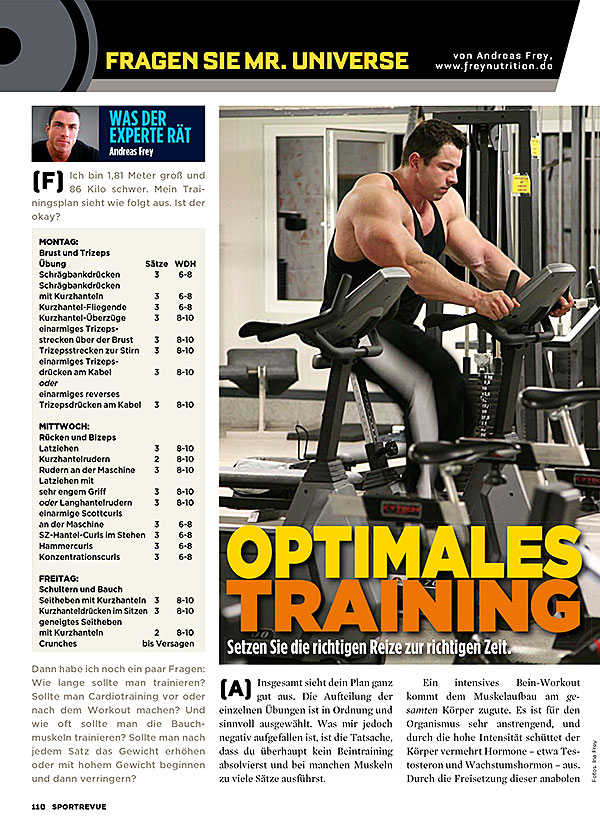COLUMN 67 |
OPTIMAL TRAINING

FOR OPTIMAL TRAINING YOU MUST SET THE RIGHT GOALS AT THE RIGHT TIME!
MONDAY:
Chest and triceps- Incline bench press 3x6-8
- Incline bench press with dumbbells 3x6-8
- Dumbbell flyes 3x6-8
- Dumbbell pullovers 3x8-10
- Triceps extensions over the chest 3x8-10
- Triceps extensions to forehead 3x8-10
- Triceps press on the cable 3x8-10 or
- reverse triceps press on cable 3x8-10
WEDNESDAY:
Back and biceps- Lat pulldown 3x8-10
- Dumbbell Rowing 2x8-10
- Rowing on the machine 3x8-10
- Lat pulldown with very close grip 3x8-10 or
- Barbell Rowing 3x8-10
- one-arm Scott curls on the machine 3x6-8
- Standing EZ dumbbell curls 3x6-8
- Hammer curls 3x6-8
- Concentration curls 3x6-8
FRIDAY:
Shoulders and stomach- Lateral raises with dumbbells 3x8-10
- Seated dumbbell press 3x8-10
- Inclined lateral raises with dumbbells 2x8-10
- Crunches to failure
ANSWER

You currently train on three days. So you either do a fourth day of training for your legs or you redistribute the muscle groups so that you can still manage with three days of training. The following split would be suitable, for example:
- Monday: Chest, shoulders, triceps
- Wednesday: legs, calves, stomach
- Friday: Back, biceps
You should be able to complete the specified number of sets in the given time without any problems. If this is not the case, you are taking too long a break between sets. Use a clock to keep to the break times. This also reduces the risk of injury. A break of one and a half minutes between sets is recommended.
You should do your cardio - excluding the warm-up, of course - after strength training. This way you won't lose any strength and you'll benefit from depleted glycogen stores after training, which promotes fat mobilization.As far as abdominal training is concerned, one session per week is usually enough. Remember that even with the best training, you won't see your abdominal muscles if the layer of fat above them is too large. So, in addition to abdominal training, it is recommended to do cardio with a high pulse rate (around 140 to 150 beats per minute) to increase your metabolism and burn more fat.
SEND US YOUR QUESTION!
Do you have any questions about bodybuilding, nutrition, training or supplements? Then send us your question by email to: INFO@FREYNUTRITION.DEThis will then be answered personally by Andreas Frey in the form of a column and published here!












